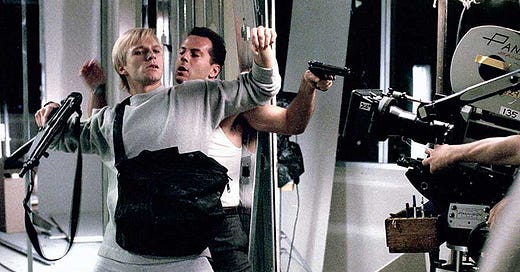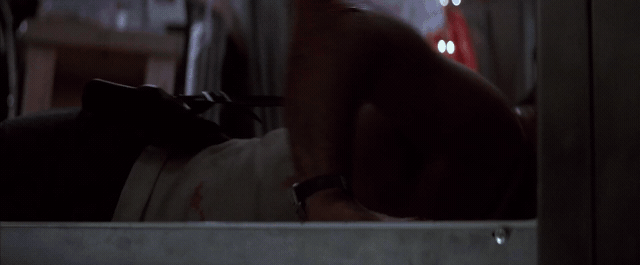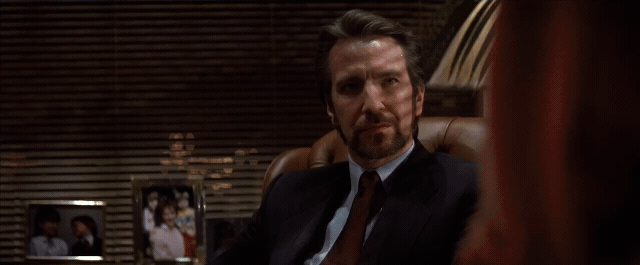DIE HARD: integrating inserts in the action
For Christmas this year we are doing some regifting. Last year we posted a small series on tilt/pants in DIE HARD and this year we’ve compiled them all into this substack post. Enjoy!
One of the many great things about Die Hard (1988) is how often it uses tilts/pans rather than cutaways to integrate inserts into the action.
In this shot, you can feel the pause as Bruce Willis (the actor) waits for the camera to find the frame before hitting the run button. Elegant.
That visual strategy — to use whip tilts/pans for inserts rather than cutaways — creates the following dynamic little sequence. Fantastic visual storytelling:
McClane -> sprinkler -> fire alarm switch -> blinking alarms -> phone call
The whip pans make it all flow... and fast. But more importantly they make it all connected to character and character action, yet we don't see the action happen. We infer it. That narrative compression is what makes the film *feel* fast.
Also, there's some fantastic camera movement throughout Die Hard. Watch how we go from a left-to-right truck (with some nice shoot-through with the metal frames) and push into an MCU on McClane as he walks towards the camera. Really dynamic without drawing attention to itself.
In our original Twitter post, we described this shot as a steadicam. But friend of Shot Zero, Cail Young, pointed out that it was likely a dolly:
That’s no steadicam 😛 the tell is the reframe wobbles as the shot gets tighter are only ever in pan/tilt. Most likely it’s a dolly on boards/the floor and a geared head like this. A super-experienced steadi operator could pull off this shot, but I’d expect to see some roll. In a modern film the shot would get stabilised and I couldn’t be so sure.
One of the effects of using pan/tilts instead of cutaways is that they can feel more casual rather than 'pay attention to this'.
This shot feels like a standard close-to-wide scene opening (which it is) rather than setting up McClane's bare feet (which obviously pays off later)
PS: how good is Bruce Willis’ reaction after looking at his family photos?
Compare the previous examples to the following scene and it's cutaway to the photo frame. The cut clearly signals to the audience that this frame will be a problem. Love that all it takes is a shift in Holly's eye-line to motivate that cut.
Also love the push-in on Gruber to show that he noticed something! Ooh, tension. We know its only a matter of time before Gruber works out Miss Gennero’s connection to Bruce Willis’ “Roy Rogers”.
We’ve talked about this kind of camera move over at DRAFT ZERO: the way the visual language has the same feeling of a 'Gruber knows she's hiding something' action line.
Here’s bonus clip we ripped from @BaneTitle on Twitter, that does some choice excerpts from McTiernan’s commentary and puts them against some visuals:








